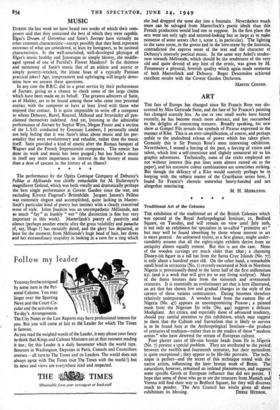Traditional Art of the Colonies THE exhibition of the traditional
art of the British Colonies which was opened at the Royal Anthropological Institute, 21, Bedford Square, on Tuesday, and will remain on view until July zoth, is not only an exhibition for specialists in so-called " primitive art " but may well be found absorbing by those whose interest in art is more general. An unlearned visitor, at a first glance, might under- standably assume that all the eighty-eight exhibits derive from an antiquity almost equally remote. But this is not the case. None of the wooden carvings are much older than 1800 ; a charming Disney-ish figure in a tall hat from the Santa Cruz Islands (No. 77) is only about a hundred years old. On the other hand, a remarkable small head in terracotta (No. r) recently excavated at Nok in Northern Nigeria is provisionally dated to the latter half of the first millennium n.c. (and is a work that will give joy to any living sculptor). Many of the finest bronzes date from the sixteenth and seventeenth centuries. It is essentially an evolutionary art that is here illustrated, an art that has shown few and gradual changes in the style of the carvers of these various communities. Dating becomes therefore relatively unimportant. A wooden head from the eastern Ibo of Nigeria (No. 47) appears an uncompromising Picasso ; a painted mask from the Nigerian Ijo tribe (No. 44a) suggests a delicate Modigliani. Art critics, and especially those of advanced tendency, should pay careful attention to this exhibition, which may suggest to them that the Cubism and Surrealism that is likely to survive is to be found here at the Anthropological Institute—the product of centuries of tradition—rather than in the studios of those " modern artists " who have deserted the stream of European culture.
Four plaster casts of life-size bronze heads from Ife in Nigeria (No. 7) present a special problem. They are attributed to the period, between the twelfth and fourteenth centuries, but their naturalism is quite exceptional ; they appear to be life-like portraits. The tech- nique is perfect—and the secret of this technique rested with the native artists, influencing the later bronze work of Benin. The naturalism, however, remained an isolated phenomenon, and suggests some specific Greek or European influence that did not persist. I hope that some of those who go to see the treasures from Munich and Vienna will find their way to Bedford Square, for they will discover much to ponder. The Arts Council has wisely given all three


































 Previous page
Previous page